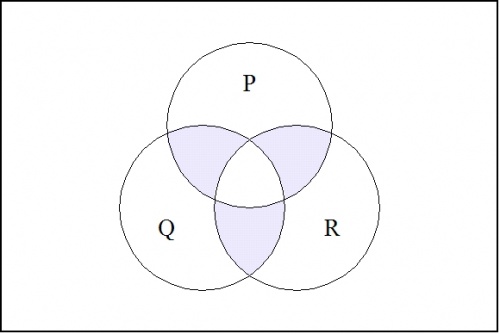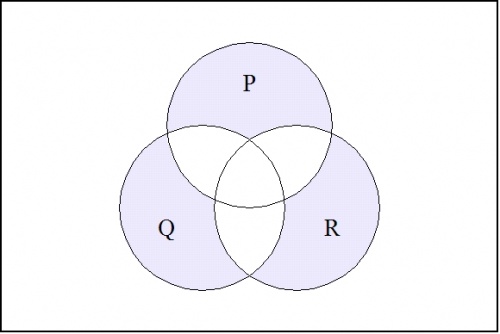Difference between revisions of "Minimal negation operator"
Jon Awbrey (talk | contribs) |
Jon Awbrey (talk | contribs) (reformat formula displays) |
||
| Line 3: | Line 3: | ||
In contexts where the initial letter <math>\nu\!</math> is understood, the minimal negation operators can be indicated by argument lists in parentheses. The first four members of this family of operators are shown below, with paraphrases in a couple of other notations, where tildes and primes, respectively, indicate logical negation. | In contexts where the initial letter <math>\nu\!</math> is understood, the minimal negation operators can be indicated by argument lists in parentheses. The first four members of this family of operators are shown below, with paraphrases in a couple of other notations, where tildes and primes, respectively, indicate logical negation. | ||
| − | : <math>\begin{matrix} | + | {| align="center" cellpadding="10" style="text-align:center" |
| − | (~) & = & 0 & = & \ | + | | |
| − | (x) & = & \tilde{x} & = & x' \\ | + | <math>\begin{matrix} |
| − | (x, y) & = & \tilde{x}y \lor x\tilde{y} & = & x'y \lor xy' \\ | + | (~) & = & 0 & = & \operatorname{false} |
| + | \\[6pt] | ||
| + | (x) & = & \tilde{x} & = & x' | ||
| + | \\[6pt] | ||
| + | (x, y) & = & \tilde{x}y \lor x\tilde{y} & = & x'y \lor xy' | ||
| + | \\[6pt] | ||
(x, y, z) & = & \tilde{x}yz \lor x\tilde{y}z \lor xy\tilde{z} & = & x'yz \lor xy'z \lor xyz' | (x, y, z) & = & \tilde{x}yz \lor x\tilde{y}z \lor xy\tilde{z} & = & x'yz \lor xy'z \lor xyz' | ||
\end{matrix}</math> | \end{matrix}</math> | ||
| + | |} | ||
It may also be noted that <math>(x, y)\!</math> is the same function as <math>x + y\!</math> and <math>x \ne y</math>, and that the inclusive disjunctions indicated for <math>(x, y)\!</math> and for <math>(x, y, z)\!</math> may be replaced with exclusive disjunctions without affecting the meaning, because the terms disjoined are already disjoint. However, the function <math>(x, y, z)\!</math> is not the same thing as the function <math>x + y + z\!</math>. | It may also be noted that <math>(x, y)\!</math> is the same function as <math>x + y\!</math> and <math>x \ne y</math>, and that the inclusive disjunctions indicated for <math>(x, y)\!</math> and for <math>(x, y, z)\!</math> may be replaced with exclusive disjunctions without affecting the meaning, because the terms disjoined are already disjoint. However, the function <math>(x, y, z)\!</math> is not the same thing as the function <math>x + y + z\!</math>. | ||
| Line 154: | Line 160: | ||
* A singular proposition ''s'' : '''B'''<sup>''k''</sup> → '''B''' can be expressed as a singular conjunction: | * A singular proposition ''s'' : '''B'''<sup>''k''</sup> → '''B''' can be expressed as a singular conjunction: | ||
| − | < | + | |
| − | + | {| align="center" cellspacing"10" width="90%" | |
| + | | height="36" | <math>s ~=~ e_1 e_2 \ldots e_{k-1} e_k</math>, | ||
| + | |- | ||
| | | | ||
| − | + | <math>\begin{array}{llll} | |
| − | + | \text{where} & e_j & = & x_j | |
| − | + | \\[6pt] | |
| − | + | \text{or} & e_j & = & \nu (x_j), | |
| − | + | \\[6pt] | |
| − | + | \text{for} & j & = & 1 ~\text{to}~ k. | |
| − | + | \end{array}</math> | |
| − | |||
| − | |||
| − | |||
|} | |} | ||
==See also== | ==See also== | ||
| − | { | + | {{col-begin}} |
| − | + | {{col-break}} | |
* [[Ampheck]] | * [[Ampheck]] | ||
* [[Anamnesis]] | * [[Anamnesis]] | ||
| Line 181: | Line 186: | ||
* [[Boolean logic]] | * [[Boolean logic]] | ||
* [[Boolean-valued function]] | * [[Boolean-valued function]] | ||
| − | + | {{col-break}} | |
* [[Continuous predicate]] | * [[Continuous predicate]] | ||
* [[Differentiable manifold]] | * [[Differentiable manifold]] | ||
| Line 190: | Line 195: | ||
* [[Logical connective]] | * [[Logical connective]] | ||
* [[Logical graph]] | * [[Logical graph]] | ||
| − | + | {{col-break}} | |
* [[Meno]] | * [[Meno]] | ||
* [[Multigrade operator]] | * [[Multigrade operator]] | ||
| Line 199: | Line 204: | ||
* [[Universal algebra]] | * [[Universal algebra]] | ||
* [[Zeroth order logic]] | * [[Zeroth order logic]] | ||
| − | + | {{col-end}} | |
==External links== | ==External links== | ||
Revision as of 04:36, 20 May 2009
In logic and mathematics, the minimal negation operator \(\nu\!\) is a multigrade operator \((\nu_k)_{k \in \mathbb{N}}\) where each \(\nu_k\!\) is a \(k\!\)-ary boolean function defined in such a way that \(\nu_k (x_1, \ldots , x_k) = 1\) if and only if exactly one of the arguments \(x_j\!\) is \(0.\!\)
In contexts where the initial letter \(\nu\!\) is understood, the minimal negation operators can be indicated by argument lists in parentheses. The first four members of this family of operators are shown below, with paraphrases in a couple of other notations, where tildes and primes, respectively, indicate logical negation.
|
\(\begin{matrix} (~) & = & 0 & = & \operatorname{false} \'"`UNIQ-MathJax1-QINU`"' * The point \((0, 0, \ldots , 0, 0)\) with all 0's as coordinates is the point where the conjunction of all negated variables evaluates to 1, namely, the point where:
To pass from these limiting examples to the general case, observe that a singular proposition s : Bk → B can be given canonical expression as a conjunction of literals, \(s = e_1 e_2 \ldots e_{k-1} e_k\). Then the proposition \(\nu (e_1, e_2, \ldots, e_{k-1}, e_k)\) is 1 on the points adjacent to the point where s is 1, and 0 everywhere else on the cube. For example, consider the case where k = 3. Then the minimal negation operation \(\nu (p, q, r)\!\), when there is no risk of confusion written more simply as \((p, q, r)\!\), has the following venn diagram:
For a contrasting example, the boolean function expressed by the form \(((p),(q),(r))\!\) has the following venn diagram:
Glossary of basic terms
See alsoTemplate:Col-break
External linksAficionados
<sharethis /> |

